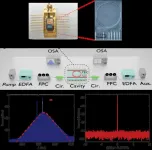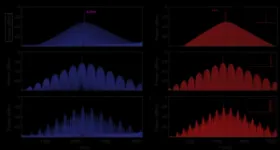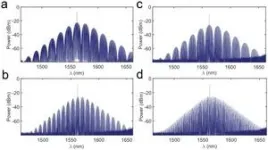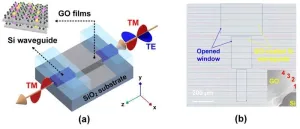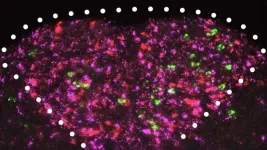A new publication from Opto-Electronic Advances; DOI 10.29026/oea.2025.240257 , discusses generation of avoided-mode-crossing soliton microcombs.
Optical frequency combs refer to spectra composed of a series of frequency components that are uniformly spaced, resembling the teeth of a comb, thus the term "optical frequency comb." In recent years, optical frequency combs generated in microresonators (known as microcombs) have attracted significant attention due to their high repetition rates, broad bandwidths, and compactness. These advantages have shown immense potential in applications such as coherent communication, precise ranging, high-resolution spectroscopy, and quantum optics. To date, numerous materials, including silica (SiO₂), silicon nitride (Si₃N₄), and lithium niobate (LiNbO₃), have been explored for the research of optical resonators. Among these, silicon oxynitride (SiON) has gained widespread use in the manufacturing of various high-quality photonic devices due to its mature processing technology and relatively low nonlinear losses. However, a critical challenge arises in the process of soliton microcombs generation: thermal effects. When light propagates within the microresonator, interactions between the light and the material generate heat, leading to temperature fluctuations inside the cavity. These fluctuations, in turn, cause a deviation of the pump frequency from the resonant frequency of the microcavity, significantly increasing the difficulty of capturing stable solitons. To address this issue, researchers have proposed various techniques, such as rapid frequency tuning, forward and backward frequency-scanning, Euler-bent microcavities, and auxiliary laser heating balance. However, these methods still face limitations in terms of operational complexity and the flexibility of temperature control. Therefore, achieving soliton microcombs in a simpler and more efficient manner has become a key focus in the development of optical frequency comb technology. Additionally, due to the influences of higher-order nonlinearities and mode crossings, previously studied soliton microcombs exhibit phenomena such as soliton oscillation tails and abrupt spectral envelope variations in both the time and frequency domains. These phenomena introduce additional noise in practical applications, thereby limiting the precision of soliton microcombs. Although researchers have generated single solitons and soliton crystals with smooth spectral envelopes through methods like phase modulation, the degree of smoothness still requires further improvement.
To address the aforementioned challenges, a collaborative team from Northwest A&F University, Shanghai Institute of Optics and Fine Mechanics, Chinese Academy of Sciences, Nanyang Technological University, and the Xi'an Institute of Optics and Fine Mechanics, Chinese Academy of Sciences, has proposed a novel auxiliary laser thermal balancing method for exciting avoided-mode-crossing soliton microcombs. This approach successfully generates soliton microcombs with ultra-smooth spectral envelopes by precise thermal regulation in a SiON microcavity with smooth sidewall and uniform thickness, thereby avoiding issues such as mode crossings and soliton oscillation tails. Figure 1(c) presents the experimental setup for generating the soliton microcomb, where the key component is a microcavity made of SiON. Figures 1(a) and (b) show the physical image of the microcavity within a butterfly-shaped package, as well as a SEM image of the microresonator. Figure 1(d) presents the spectrum of a single soliton (blue curve), with the red dashed line representing the fit of the spectral envelope to a sech² function. Figure 1(e) illustrates the equidistant distribution of the spectral envelope of the single soliton, indicating that the soliton microcomb is generated in a low-noise state.
Figures 2(a-c) show the experimental results for the generated single soliton, dual soliton, and quadruple soliton states, with the spectrum of the auxiliary laser being filtered out. The experimental results indicate that the generated solitons avoid interactions between different modes, thus possessing extremely smooth spectral envelopes. Importantly, this phenomenon is independent of the pump itself. Figures 2(d-e) present the theoretical simulation results based on the Lugiato-Lefever equation. A comparison with Figures 2(a-c) reveals that the spectra of the generated solitons closely match the theoretical simulations. This smooth spectral envelope with low redundant noise and minimal inter-line power variations is crucial for applications in precise ranging, spectroscopy, and astronomy. Furthermore, our experimental study also demonstrates the presence of Raman-induced self-frequency shift in the spectrum, which manifests as a redshift of 4.4 nm at the spectral center of the pump wavelength, as shown in Figure 2(a). From this, the Raman shock time can be deduced to be 2.7 fs.
Interestingly, further research demonstrates that the proposed soliton excitation scheme allows for the flexible generation of different dual-soliton states by controlling the temperature of the microcavity as well as the wavelength and power of the auxiliary light. Figure 3 shows the smooth spectral envelopes of four distinct dual-soliton states obtained experimentally. These different dual-soliton states exhibit significantly different spectra, which result from the interference between the Fourier components of each individual soliton.
This study applies an auxiliary laser thermal balancing scheme, which enables flexible thermal regulation, to a silicon oxynitride microresonator with smooth sidewalls and uniform thickness. This approach successfully addresses the thermal effects encountered during the microcomb generation process and generates soliton states with ultra-smooth spectral envelopes. This advancement opens new avenues for the practical application of micro-combs in fields such as precision measurement, spectroscopic analysis, and astronomical observation. Moreover, the simplicity and efficiency of the auxiliary laser thermal balancing scheme enhance its feasibility for practical applications, potentially accelerating the commercialization of optical frequency comb technology. Moving forward, the research team will continue to explore the excitation mechanisms of soliton microcombs on other material platforms, further advancing the development of optical frequency comb technologies.
Keywords: perfect solitons / thermal dynamics / auxiliary laser heat balance / Raman effect
# # # # # #
Mulong Liu is an Associate Professor and Master Supervisor in the Department of Physics, School of Science, Northwest A&F University. His primary research areas include nonlinear optics, micro/nano photonics, and the dynamics of optical solitons. He has published more than 20 academic papers in journals such as Opto-Electronic Advances, Photonics Research, Physical Review Applied, Optics Express, and Optics Letters. He has also presided projects funded by the National Natural Science Foundation of China (Youth Program) and the Basic Research Program of Shaanxi Province.
Peng Xie is a Full Professor,Principal Investigator/Team Leader of Nano-Photonics and Photonic Networks group at Shanghai Institute of Optics and Fine Mechanics, Chinese Academy of Sciences and Tutor of College of Materials Science and Optoelectronics Engineering, University of Chinese Academy of Sciences. He obtained the High-level Talent Program and received the appointment of professor in 2024.
Dr. Guangwei Hu is the Nanyang Assistant Professor in School of Electronic and Electric Engineering, Nanyang Technological University in Singapore. He received the B.Sc. in physics from Harbin Institute of Technology in 2016, Ph.D. degree from National University of Singapore in 2020 (during which he was a visiting scholar in UT Austin and CUNY ASRC), and the postdoctoral training in Stanford University. His research interest is nanophotonics, including the theory, numerical modelling, and materials such as 2D materials, for broad applications including bio-imaging, computations, photonic chips, energy and others. He has published more than 100 papers, including Nature (4), Science, Nature Photonics, Nature Nanotechnology, Nature Electronics, Nature Communications, Science Advances, PRL and many others. His work has been featured as the Top 10 Breakthrough in Physics of 2020 by Physics World, Optics and Photonics News (Year of Optics in 2021), China’s Top 10 Breakthrough in Optics in 2021, and many others. He received Early Career Awards in Nanophotonics (2023), MIT Technology Reviews, Innovators Under 35 of 2022 (China), Forbes 30 Under 30 of 2023 (Asia), the 20th Anniversary Challenge Award from Optica Foundation, Rising Star of Light in 2020 by Light: Science & Applications, NUS President’s Graduate Fellowships and various other awards. He is an associate editor of npj nanophotonics.
# # # # # #
Opto-Electronic Advances (OEA) is a rapidly growing high-impact, open access, peer reviewed monthly SCI journal with an impact factor of 15.3 (Journal Citation Reports for IF2023). Since its launch in March 2018, OEA has been indexed in SCI, EI, DOAJ, Scopus, CA and ICI databases over the time, and expanded its Editorial Board to 34 members from 17 countries.
# # # # # #
More information: http://www.oejournal.org/oea
Editorial Board: http://www.oejournal.org/oea/editorialboard/list
All issues available in the online archive (http://www.oejournal.org/oea/archive).
Submissions to OEA may be made using ScholarOne (https://mc03.manuscriptcentral.com/oea).
ISSN: 2096-4579
CN: 51-1781/TN
Contact Us: oea@ioe.ac.cn
Twitter: @OptoElectronAdv (https://twitter.com/OptoElectronAdv?lang=en)
WeChat: OE_Journal
# # # # # #
Liu ML, Wei ZQ, Zhu HT et al. Soliton microcombs in optical microresonators with perfect spectral envelopes. Opto-Electron Adv 8, 240257 (2025). doi: 10.29026/oea.2025.240257
END
